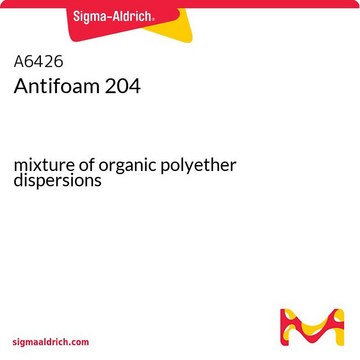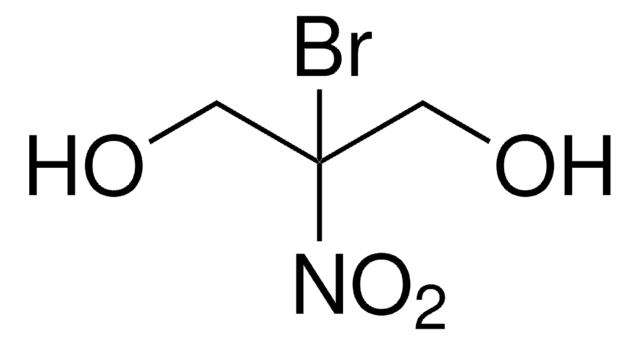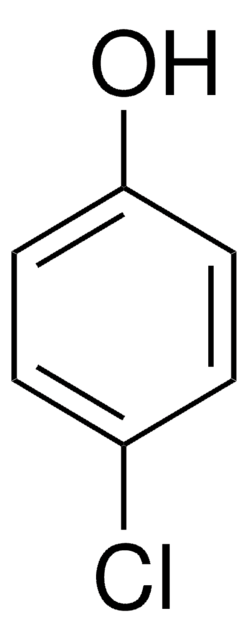112054
1,1,1-Trichloro-2-methyl-2-propanol hemihydrate
98%
Synonym(s):
β,β,β-Trichloro-t-butanol, β,β,β-Trichloro-tert-butyl alcohol hemihydrate, Acetone chloroform, Chloretone, Chlorobutanol
Sign Into View Organizational & Contract Pricing
All Photos(1)
About This Item
Linear Formula:
Cl3CC(CH3)2OH · 0.5H2O
CAS Number:
Molecular Weight:
186.46
Beilstein:
878167
EC Number:
MDL number:
UNSPSC Code:
12352100
PubChem Substance ID:
NACRES:
NA.22
Recommended Products
Quality Level
Assay
98%
form
solid
mp
77-79 °C (lit.)
functional group
chloro
SMILES string
O.CC(C)(O)C(Cl)(Cl)Cl
InChI
1S/2C4H7Cl3O.H2O/c2*1-3(2,8)4(5,6)7;/h2*8H,1-2H3;1H2
InChI key
WRWLCXJYIMRJIN-UHFFFAOYSA-N
Related Categories
General description
1,1,1-Trichloro-2-methyl-2-propanol hemihydrate (chlorobutanol) converts benzisoxazole to α-aryloxyisobutyric acid. 1,1,1-Trichloro-2-methyl-2-propanol hemihydrate (chlorobutanol) forms eutectic with dimethyl sulfone, which is the most suitable media for freeze-drying due to its high solubilizing ability and a good rate of solvent removal.
Application
1,1,1-Trichloro-2-methyl-2-propanol (chlorobutanol) is a preservative that can be quantified using capillary electrophoretic method.
Signal Word
Warning
Hazard Statements
Precautionary Statements
Hazard Classifications
Acute Tox. 4 Oral
Storage Class Code
11 - Combustible Solids
WGK
WGK 3
Flash Point(F)
212.0 °F - closed cup
Flash Point(C)
100 °C - closed cup
Personal Protective Equipment
dust mask type N95 (US), Eyeshields, Gloves
Choose from one of the most recent versions:
Already Own This Product?
Find documentation for the products that you have recently purchased in the Document Library.
Customers Also Viewed
Antoni Ivorra
PloS one, 6(8), e23456-e23456 (2011-08-19)
Miniaturization of active implantable medical devices is currently compromised by the available means for electrically powering them. Most common energy supply techniques for implants--batteries and inductive couplers--comprise bulky parts which, in most cases, are significantly larger than the circuitry they
Raymond J Cvetovich et al.
The Journal of organic chemistry, 70(21), 8560-8563 (2005-10-08)
A practical synthesis of benzisoxazole 1 and its conversion to alpha-aryloxyisobutyric acid 2 using 1,1,1-trichloro-2-methyl-2-propanol (chloretone) was developed. Benzisoxazole 1 was formed in high yields by the action of either methanesulfonyl chloride/base upon intermediate oxime 8 or with thionyl chloride/base
Jared Talbot et al.
The Journal of experimental biology, 214(Pt 7), 1063-1067 (2011-03-11)
Changes in animal behavior resulting from genetic or chemical intervention are frequently used for phenotype characterizations. The majority of these studies are qualitative in nature, especially in systems that go beyond the classical model organisms. Here, we introduce a quantitative
M S Tesconi et al.
Journal of pharmaceutical sciences, 88(5), 501-506 (1999-05-07)
This study investigates the use of solid, organic compounds to lyophilize drugs without conventional freeze-drying equipment. The aim of the investigation is to find a pharmaceutically acceptable solvent or solvent combination that is appropriate for freeze-drying on the basis of
Małgorzata Jaworska et al.
Journal of separation science, 28(2), 137-143 (2005-03-10)
Preservatives are used to protect pharmaceutical formulations from microbial attack during the period of administration to the patient. Because of their biological activity, preservatives have to be identified and assayed according to the same rules as apply to active components.
Our team of scientists has experience in all areas of research including Life Science, Material Science, Chemical Synthesis, Chromatography, Analytical and many others.
Contact Technical Service













